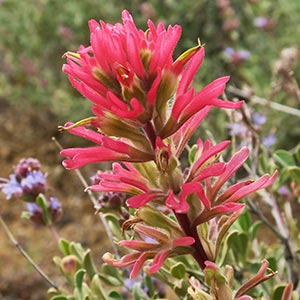Castilleja angustifolia
Castilleja peckiana
narrow-leaf paintbrush, northwestern Indian paintbrush, northwestern paintbrush, violet desert paintbrush
peak paintbrush, Peck's Indian paintbrush, Peck's paintbrush
few to many, ascending to erect, branched, especially near base, sometimes unbranched, hairs sparse to dense, spreading to retrorse, long, sometimes short, soft to stiff, usually mixed with short-glandular ones, sometimes viscid.
few to many, erect or ascending, often branched distally, sometimes unbranched, sometimes with short axillary shoots, proximal hairs retrorse to appressed, short to moderately long, distal hairs spreading, longer, soft, often mixed with short stipitate-glandular ones.
brown or purplish, sometimes green, linear to lanceolate or broadly lanceolate, 1.2–7(–7.5) cm, not fleshy, margins plane, sometimes ± wavy, involute or flat, (0–)3–5-lobed, rarely with secondary lobes, apex acuminate to rounded;
lobes spreading, oblong or lanceolate to linear-lanceolate, apex acute to rounded.
green, linear-lanceolate, rarely broadly lanceolate, (1.2–)2.5–8(–9) cm, not fleshy, margins plane, flat or involute, 0(–3)-lobed, apex acute to rounded;
lobes ascending-spreading, narrowly lanceolate to linear, apex acute or obtuse.
2.5–20 × 1.5–5 cm;
bracts proximally greenish or dull purplish, distally pink, magenta, pink-purple, reddish pink, pale yellow, pale yellow-orange, pale orange, or white, rarely reddish or orange-red, lanceolate to oblong, 3–5(–9)-lobed, sometimes with secondary lobes;
lobes spreading or ascending, oblanceolate or linear, proximal lobes often much longer than distal, proximal lobes arising below or a little above mid length, apex acute to rounded.
(2–)4–17 × 1.5–3 cm;
bracts proximally greenish, distally red, orange-red, or orange, proximal sometimes lanceolate, distal broadly lanceolate to ovate, (0–)3(–7)-lobed;
lobes spreading to ascending, linear to lanceolate, long, arising near or below mid length, central lobe apex rounded, lateral ones acute.
straight, 18–27(–32) mm;
tube 8–17 mm;
beak usually long-exserted, adaxially green or pink, 8–15 mm;
abaxial lip deep green, reduced, inconspicuous, 1–2.5 mm, 5–20% as long as beak;
teeth incurved to ascending, deep green, 0.5–1.5 mm.
straight, 23–30(–35) mm;
tube 12–20 mm;
beak exserted, adaxially green, 8–12(–14) mm;
abaxial lip pale to deep green, reduced, rounded, 0.5–1.5 mm, 10–20% as long as beak;
teeth erect to incurved, green, (0.4–)0.7–1.2(–2) mm.
proximally green, yellow, brown, or purple, lobes colored as bract lobes, sometimes with a yellow band between proximal and distal parts, 13–25(–28) mm;
abaxial clefts 3–8 mm, adaxial 5–9(–12) mm, clefts 30–50% of calyx length, deeper than laterals, lateral (1–)1.5–4(–5) mm, 10–25% of calyx length;
lobes lanceolate to oblong, abaxials wider than adaxials, apex acute to rounded.
proximally pale yellow or greenish, distally colored as bracts, (15–)18–28 mm;
abaxial and adaxial clefts 6–12 mm, 40–45% of calyx length, deeper than laterals, lateral 2.5–8 mm, 20–30% of calyx length;
lobes linear to narrowly lanceolate, apex acute to acuminate.
= 72, 96, ca. 120.
Castilleja angustifolia
Castilleja peckiana
Varieties 3 (3 in the flora).
Much confusion exists concerning Castilleja angustifolia and the closely related C. chromosa. Sometimes C. chromosa is treated as a variety of C. angustifolia, using the name C. angustifolia var. dubia. The latter name is used here to represent a different assemblage of plants, not including C. chromosa. At other times, C. chromosa is synonymized completely under C. angustifolia. However, the two species are in most cases easily separable, and where they are sympatric there is little evidence of intergradation. Both C. angustifolia var. dubia and C. chromosa are accepted here. See additional comments under 3b. C. angustifolia var. dubia and 15. C. chromosa.
(Discussion copyrighted by Flora of North America; reprinted with permission.)
When describing Castilleja peckiana, Pennell noted that its variation approached C. hispida on one hand and C. miniata on the other, and it is likely of allopolyploid derivation. L. R. Heckard (1968) found chromosome numbers of n = 36, 48, and ca. 60. He hypothesized that C. chromosa, C. hispida var. acuta, and C. miniata were likely involved in its ancestry, and possibly C. pruinosa as well. Heckard suggested subsequent introgression among the derived forms introduced further complexity. Though complex, these forms are self-perpetuating and appear morphologically stable within their range.
(Discussion copyrighted by Flora of North America; reprinted with permission.)
1. Bracts distally usually pink to pink-purple; s Idaho, sw Montana, se Oregon, nw Wyoming. | var. angustifolia |
1. Bracts distally yellow, yellow-orange, pale orange, white, pink, reddish pink, or magenta; se Idaho, e Nevada, sw South Dakota, w Utah, ec Wyoming. | → 2 |
2. Bracts distally usually yellow to pale orange or white; ec Wyoming, adjacent sw South Dakota. | var. dubia |
2. Bracts distally usually yellow, yellow-orange, white, pink, or reddish pink; se Idaho, e Nevada, w Utah. | var. flavescens |


